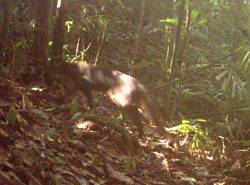Rare bay cat recorded in the extensions of Pulong Tau National Park
11 January 2011

Bornean bay cat in Pulong Tau National Park (PTNP)
A mature bay cat is normally the size of a large domesticated cat; albeit with an extra-long tail. It has two color morphs, with red much more common than gray. Three images were captured recently via camera traps set by the Forest Department Sarawak and Sarawak Forestry Corporation under the ITTO-supported Pulong Tau NP Phase II project. The camera traps were sponsored by the Sarawak Timber Association (STA).
The last photograph of the wild bay cat in Sarawak was also captured by camera traps in Lanjak Entimau Wildlife Sanctuary (management of which has also been supported by a series of ITTO-funded projects), in a joint study initiated by UNIMAS in 2003. Other than these photos, most other information on the cat consists of historical records, morphological descriptions and anecdotes from various sources.
Pulong Tau National Park is located in Sarawak’s northern highlands in Miri and Limbang Divisions in the northeast of Sarawak. The park was gazetted in 2005 to protect an area of about 60,000 ha of pristine rain forest. It includes Mount Murud, Sarawak’s highest peak (2,424 m), and the Tama Abu Range. It is the site for the ITTO-sponsored transboundary biodiversity conservation project with the Kayan Mentarang National Park in East Kalimantan, Indonesia implemented by the Forest Department Sarawak. Donors to the project are listed below; technical input has also been provided by the Swiss agency Intercooperation.
The presence of the bay cat further heightens the importance of PTNP as a reservoir of the highlands’ rich biodiversity, of which many species are endemic, rare and/or threatened.
Project donors: Switzerland (SECO), Japan, USA and Norway